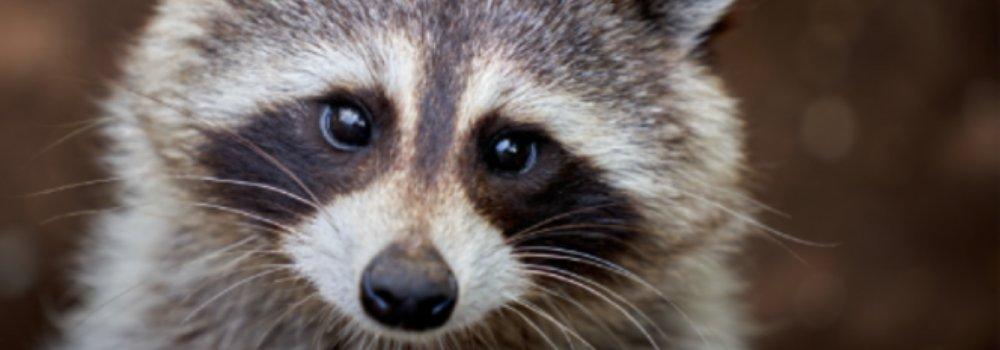
Raccoons are often depicted in children’s cartoons as adorable, wily bandits because of their mask-like markings around their eyes and the unique ways in which they use their paws. These furry creatures are interesting to watch in real life, and they play a beneficial role in the ecosystem. However, when raccoons start to invade our yards and homes, they can become dangerous and destructive. Learn how to identify raccoons, what they eat, and how to deter them from entering your property.
What Do Raccoons Look Like?
Raccoons are mammals of the family Procynonidae. The common raccoon is most recognizable by the black coloring around its eyes, resembling a mask. They have bushy tails with bands or rings around them, a stocky torso, four legs, and measure about 2 feet in length (a little larger than a cat but smaller than a medium-sized dog).
Their furry coat is usually colored grayish-white and black, and they have paws that resemble slender human hands. The paws have five toes that give raccoons a wide range of dexterity when climbing and handling food.
These mammals are nocturnal wildlife pests that can be seen roaming about alone or in groups of up to four. They tend to be most active at night, sleeping in the daytime.

What Do Raccoons Eat?
Raccoons are omnivores, eating whatever is available to them. Their preferred foods are fruits, nuts, berries, frogs, insects, plants, eggs, and crayfish.
The raccoon is well known for engaging in a behavior that looks like they’re washing their food before eating it. They douse the food items with water or rub them with their hands before consuming their meal. Scientists believe they’re not actually cleaning their food, but rather are carefully examining what they’re holding before ingesting it.
Raccoons in suburban neighborhoods are also drawn to birdseed, pet food, and water in fountains or bowls. They will go through trash cans looking for anything that isn’t rotten.
Where Do Raccoons Live?
Raccoons can live in nearly any type of environment. In the wild, raccoons prefer to sleep in trees, where they’re safe from their predators, mostly wild cats. However, raccoons are adaptable and will easily thrive anywhere, even in urban areas where food is plentiful in the form of trash.
Raccoons will also often move into other animals’ abandoned dens or make their nests in hollow logs, sheds, barns, attics, beneath porches, and inside people’s homes if easy entry is available.
During warmer months, raccoons sleep between 6-8 hours a day but sleep longer in the colder months when food is scarcer. In the winter, rather than hibernating, raccoons go into a state of torpor, when they sleep for days or weeks at a time. A raccoon can live for 2-3 years.
Are Raccoons Dangerous?
Raccoons are the primary carriers of the rabies virus in the U.S., although most rabid raccoons die within 3 days of contracting rabies. If any raccoon bites or scratches you, it’s best to go to the hospital to get rabies treatment, just in case.
A rabid raccoon will display some of the following signs and behaviors:
- Staggered, uncoordinated wandering
- Frothy discharge from the eyes or mouth
- Thin body and dirty, matted fur
- High-pitched wailing sounds
- Walking as though the ground is very hot
- Activity during the day, rather than at night
Raccoons can transmit other infections, from Listeriosis to tetanus or salmonella.
How To Keep Raccoons Out of Your Yard
Raccoons living or foraging in your yard can be a danger to you or your pets, especially at night. They can also cause damage to your vegetation and gardens.
You can try to deter these critters from making their home on your property by:
- Keeping the yard lit up at night with motion-activated security lighting. The sudden light will frighten the animals.
- Keeping trash cans tightly shut.
- Cleaning up all food from your yard each night, especially after outdoor parties.
- Taking in all pet bowls at night.
- If you keep bird feeders filled, hang them on high poles that are hard for raccoons to climb.
- Grow plants that raccoons don’t like to eat, particularly ones with prickly vines that hurt their feet. They hate the smell of peppermint, garlic, and onions, too.
- Cover water sources, such as birdbaths and upside-down pots that collect rainwater.
The main way to prevent raccoons from coming inside the home is to close off any points of access to them. Seal possible points of entry with wired mesh or wood in open spots where they may enter your home, such as under the porch or deck and around your shed or garage.
Keep your garbage cans shut and consider locking them so raccoons can’t get into them. You can even weigh down the lid with a cinder block if it won’t lock. It may be helpful to place caps or chicken wire on top of chimney openings or seal gaps along the outside of your attic walls, as well.
Categories
RELATED POSTS


